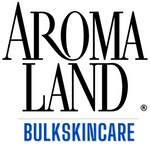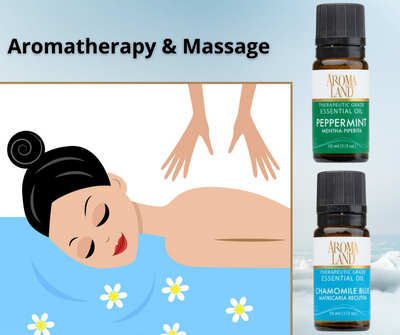Top 10 Essential Oils Every Massage Therapist Should Consider Using!
Posted by Kathy Sadowski, Licensed Massage Therapist, Registered Aromatherapist, MA on on Jul 27th 2022
Attention Massage Therapists: Aromatherapy combined with a massage treatment offers significant added benefits! Whether you are using a cool mist diffuser to enhance the mood or mixing essential oils into your body lotion, cream, or oil base, both air disbursal and topical applications can help improve the results of your treatments.
This article will talk about how to include aroma oils in your massage therapy practice. It will also discuss the top 10 essential oils every massage therapist should consider using.
The Best Ways to Use Essential Oils with a Massage
First, it is important to consider that not everyone likes certain aromas, and that essential oils can be contraindicated with certain medical conditions. Ask your client before incorporating aromatherapy into a massage session. Review the client intake form and be aware of essential oils to avoid with common conditions such as (but not limited to) pregnancy, breastfeeding, asthma, or sensitive skin.
With topical use, skin patch test a small area before applying to large areas or on the face.
Scents can be inhaled and have a noticeable impact on mood. Diffusers work great! Be sure to ask your client before disbursing aromas in the air. Follow the instructions on the diffuser. Diffuse intermittently for 20-minute intervals in a well-ventilated room. Diffuse for shorter time periods and more diluted for those who should have less exposure.
Another way to incorporate a pleasant scent into a treatment is to place a drop of essential oil on a tissue. Set it near the breathing area of the recipient.
Therapeutic essential oils can be blended in a carrier oil or unscented base. For non-hot essential oils, mix 10 drops of essential oil per ounce of carrier oil. Then apply topically. Dilute more heavily for those with sensitive skin and avoid with possible contraindications.
Best Aromatherapy Massage Essential Oils
Below is an overview of ten key oils to consider incorporating into your bodywork sessions.
Bergamot (Citrus bergamia) – This citrus-sweet floral scent has been studied for its mood-brightening potential. Be sure to select FCF: furocoumarin-free bergamot with topical use to avoid possible skin damage for those going out in the sun. Further, store well sealed in a cool area to reduce the potential of oxidation. This oil, if oxidized, can cause skin irritation.
Eucalyptus (Eucalyptus globulus) offers a cool, breath-opening scent. It can be helpful for those who have nasal congestion. Topically, eucalyptus can be incorporated into a massage for aching muscles. Another good use for this oil is to mix 10 drops of it per ounce of laundry detergent to help freshen and reduce stains on your sheets and blankets. Avoid use with children, breastfeeding women, and certain health conditions, including asthma.
German Chamomile (Chamomilla recutita or Matricaria recutita) is a warm floral known for its calming effect. Topically, it can help with minor scrapes, itching, and other skin issues. Generally, it is a gentle essential oil. But avoid in those with allergies to plants in the Asteracea family, such as ragweed.
Juniper Berry (Juniperus communis) has an evergreen-fruity scent that is uplifting and reminiscent of a hike in the woods. It is commonly used for respiratory complaints. It is also good for muscle aches, poor flow, and warming the tissue. Avoid during pregnancy or breastfeeding. Avoid with young children and urinary diseases (including kidney stones).
Lavender (Lavendula angustifolia) is a beloved green floral with deeply calming potential. It can help soothe mental tension and improve sleep for some people. Topically, it has long been used as a folk remedy for minor skin afflictions such as burns, scrapes, and itchy bug bites. Properly dilute all essential oils, including lavender, before topical use.
Lemon (Citrus limonum) – This bright citrus scent is awakening and happy. It is a strong scent that can help deodorize unpleasant odors. Topically, it has astringent-like properties. Avoid topical use with sun exposure, which can cause skin damage. Also, store properly, as this light oil can oxidize even more easily than most oils.
Patchouli (Pogostemon cablin) is a smokey-earthy scent reminiscent of the hippy era. It can be used to help cleanse a room of negative energy. Topically, it may give the skin a youthful glow and help with wrinkles and discolorations. Note: patchouli is a strong scent, so use sparingly.
Peppermint (Mentha x piperita) – Minty and fresh, this oil can help boost alertness. The aroma has also been used to help open breathing, reduce tension headaches, and lesson indigestion. Topically, peppermint offers a cooling effect and calms muscle aggravations and local swelling. Do not use it with pregnant or breastfeeding women, young children, or with certain medical conditions.
Pine Needle (Pinus sylvestris) may bring fond memories of a Christmas tree. This cheery smell can help ease a cough and congestion. It has also been used for muscle stiffness and to improve flow. Store away from heat, sun, and air; oxidized pine oil can cause skin sensitivity.
Tea Tree (Melaleuca anternifolia) is often described as having a “medicinal” scent. It is most well-known for its use on the feet to help with odor and potential fungus. It has also been used for a variety of minor skin afflictions. It is a common ingredient in over-the-counter products for wounds, burns, and fungal infections. Dilute properly with topical applications and discontinue use if any irritations occur.
In Summary…
Essential oils can be a wonderful addition to a massage therapy practice. Ask your client before using an aromatherapy product in their bodywork session. Be sure to identify possible contraindications before use and properly dilute. While this article lists ten favorite oils to try first, you may quickly find yourself interested in expanding your aromatherapy repertoire!
Note: Essential oils are not for internal use. Dilute properly with topical use. Some essential oils may be contraindicated with certain medical conditions. Ask your doctor if you have any questions before use.
This information has not been evaluated by the Food and Drug Administration and is not intended to diagnose, treat, prevent, or cure a disease.

